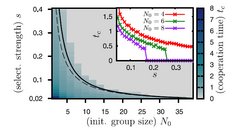Monday, 18 October, 2010
When it pays to bear the extra cost -
The effects of population dynamics on evolution
The evolutionary biologist Theodosius Dobzhansky once famously stated that nothing in biology makes sense except in the light of evolution. Today, nearly 40 years later, questions about the origin of life, the evolution of species and the factors underlying their diversity remain at the heart of biological research. Among the many factors that play a role in evolution, perhaps the most basic is selection. Individuals are in effect in competition with one another because they differ in their capacity for survival and reproduction. Variations in these parameters have a direct effect on population dynamics. Understanding the interplay between all evolutionarily relevant factors in any given situation is an enormous challenge, says LMU biophysicist Professor Erwin Frey, who is also a member of the Cluster of Excellence Nanosystems Initiative Munich (NIM) at LMU Munich. We have constructed and analyzed a theoretical model of the interaction between population growth and selection intensity. It turns out that demographic fluctuations can play a significant role in determining the evolution of growing populations. Many populations can evolve in unexpected directions as a result of stochastic variations in reproductive success and death rate. The system used by Frey and his colleagues Anna Melbinger and Jonas Cremer as the biological basis of their model is the bacterial biofilm. Biofilms develop when cells settle on a surface and form special structures that attach them firmly to the substrate and to each other. A biofilm is thus the result of cooperation between the members of a population of bacteria, and it demonstrates the phenomenon known as the dilemma of cooperation very clearly. When individual cells synthesize and secrete substances that their neighbors can exploit, the whole community benefits, including those cells that make none. Indeed, the latter should be at an advantage, because they avoid the metabolic costs involved in producing the compounds. In the long term, the cheaters should therefore come to dominate the population. Our model reveals that demographic fluctuations during phases of growth can lead to transient increases in the fraction of cells that show cooperative behavior, says Frey. Intermittent bursts of growth occur in natural biofilms, and could contribute to stabilizing cooperative interactions. (Physical Review Letters online, 18 October 2010)
Presseinformation der LMU (deutsch)
Press information LMU (english)
Publication "Evolutionary Game Theory in Growing Populations"


